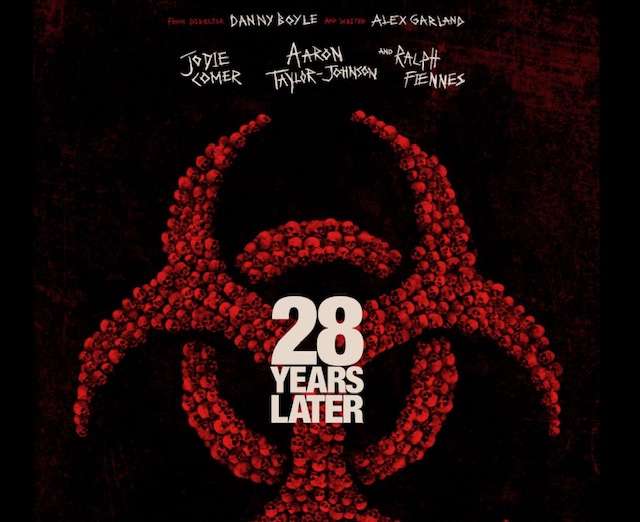28 Years Later is the third movie in the zombie picture trilogy, including 28 Days Later and 28 Weeks Later, the former directed by Alex Garland and Danny Boyle, and the latter directed by Juan Carlos Fresnadillo.

Garland and Boyle have now banded together to write and direct their third film, 28 Years Later as the first movie of a new trilogy, depicting the same post-apocalyptic world.
The film exposits an iconically cold open: a group of siblings sit still and quiet watching an episode of the ‘Teletubbies’, told by their mother not to leave the room or look away from the TV screen. The children watching the eerily benign Teletubbies dancing on the screen are disrupted by a hoard of flesh-eating creatures infected by ‘The Rage’ virus. While many are slaughtered, one child escapes.
Boyle and Garland then take us 28 Years Later, to the present. On a tidal island in the North of England, quarantined people have created a new isolated community. A young boy, Spike (Alfie Williams) cares for his bedridden mother Isla (Jodie Comer), and prepares to leave the island for the first time, to go hunting with his strapping father (Aaron Taylor-Johnson).
While out hunting with his father, Spike discovers a fire on the horizon, and learns of the insane doctor, Ian Kelson (Ralph Fiennes), whom Spike latches on to as the only person who may be able to provide a cure for his declining mother. Spike decides to leave the village and take his mother out into the mainland, seeking the doctors’ help.
The rest of this oddball film then follows their journey as a Coming of Age story, with the elements of zombie horror taking a backseat. The two bump into a Swedish soldier carrying news of the outside world, a pregnant zombie, and eventually they come across the doctor, and find out what he has been working on in isolation for so long.
Comer gives a brilliant performance of a mother oscillating between vulnerable delirium, and nurturing towards her son, who has had to grow up prematurely.
Spike’s parents provide him with juxtaposing rites of passage. Spike’s father thrusts him into a world of physical danger, one that demands Spike to be strong, stoic and detached. But he does not allow his son to speak openly about the trials he faced on the mainland, and instead fabricates his sons’ prowess in a hero story for the rest of the village.
However, throughout Spike’s journey with his mother, Spike must come to terms with the violent world he has been raised into, and grapple with loss.
With this much more sincere, confronting rite of passage, Boyle and Garland halt the action horror this film was destined for in its tracks. Unconventionally, our protagonist swivels around to face the cathedral of skeletons behind him- those fought, killed, and lost, on both sides. 28 Years Later pushes us to mourn and accept, with the concept of ‘Memento Mori’- remember the dead.
28 Years Later was shot predominantly on an iPhone camera, its HD quality certainly a step up from the first movie, 28 Days Later. Perhaps Boyle and Garland got over-excited with this new upgrade, for some of the movie shots seemed reminiscent of an iPhone advert- showing off the quality and hardiness of the camera lens with slow motion stunt-like visuals, and sediment from the scene like mud or blood flecking the frame. With these ‘iPhone advert’ like scenes , flashbacks to the zombie packs’ movements shot in pixelated infrared, and montage scenes that use archival footage of medieval soldiers and archers, the editing felt a bit too disjointed.
The cult-like undertones of Spike’s isolated village and the movies’ half-set up religious critique makes fertile ground for an exploration of post-apocalyptic society, akin to predecessor 28 Days Later. I thought 28 Years Later would continue this trend of dystopian social commentary, however Boyle and Garland gleefully subvert it. Rather, they turn the magnifying glass towards Spike and Isla’s journey outside of the village in a Coming of Age journey.
Oh well, I’m hoping these balls of string will be unravelled in the movies to come.
Many world-building elements, like the nature of the quarantine zones, how The Rage Virus presents itself differently amongst the infected zombies, how a zombie can give birth to a human baby – OOPS SPOILER ALERT! – and the gang of Jimmy Savile cosplayers, are left unexplained.
28 Years Later had many loose ends yet to tie up, leaving the film feeling unfinished, but it aptly wets the palate for the sequels to come!
I’d rate the movie 7 out of 10 – especially for a zombie apocalypse, it broke genre conventions refreshingly.
* By Izzy Ercleve
Izzy Ercleve is a Gen Zedder, Shenton College graduate and is taking a gap year before making big life decisions. A writing enthusiast, she is interning at Fremantle Shipping News to learn more about the world of journalism!
~~~~~~~~~~~~~~~~~~~~~~~~~~~~~~
~ If you’d like to COMMENT on this or any of our stories, don’t hesitate to email our Editor.
~ WHILE YOU’RE HERE –
PLEASE HELP US TO GROW FREMANTLE SHIPPING NEWS
FSN is a reader-supported, volunteer-assisted online magazine all about Fremantle. Thanks for helping to keep FSN keeping on!
~ Don’t forget to SUBSCRIBE to receive your free copy of The Weekly Edition of the Shipping News each Friday!






